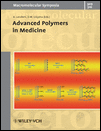A Blend of Poly(ε-caprolactone) and Poly[(ε-caprolactone)-co-glycolide] with Remarkable Mechanical Features and Wide Applicability as Biomaterial
Abstract
Hydrolytic degradation of poly(ε-caprolactone) [PCL] can be enhanced by introduction of 8 wt.% glycolide leading to poly[(ε-caprolactone)-co-glycolide] (PCG), which has a low elongation at break εB of 4%. PCG/PCL blends (50/50 w/w) combined the advantageous features of its individual components such as mechanical properties similar to pure PCL (εB, Blend: 900 ± 230%; εB, PCL: 730 ± 50 at 20 °C), water uptake rates during degradation similar to pure PCG, and linear mass loss during bulk degradation independent from sample dimensions. The outcome of cytotoxicity studies was depending on the cell type with promising results, e.g., for Tenon fibroblasts. Easy processing of the blend was demonstrated by melt compression, foaming with CO2, and hot melt extrusion, suggesting a wide applicability as biomaterial, e.g., as drug carrier.




